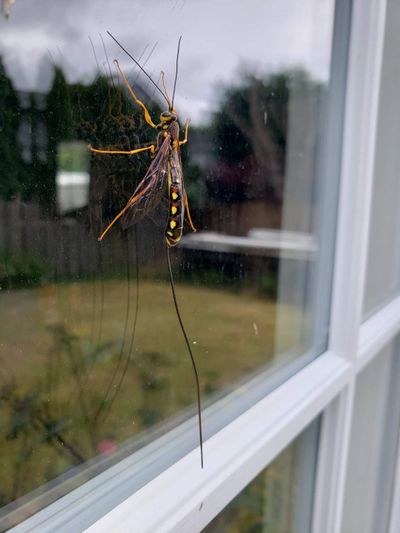Bugging the Northwest: The scary-sounding ‘stump-stabber’ wasp is all size and no sting

Up close, it’s a terrifying insect. With what appears to be a 4-inch stinger, it buzzes around wooded areas and occasionally perches on people’s windows, as you can see by the photograph taken in Washington County, Oregon.
Meet Megarhyssa nortoni, commonly known as the giant ichneumon wasp. And yes, many of them reside here in the state of Washington.
But there’s no need to pack your bags and move to the cornfields of the Midwest to escape them. The needle-like object attached to the female wasp’s body isn’t a stinger but an ovipositor, an ultra-thin tube the females use to bore into decaying or dead wood to deposit eggs, according to entomologist Michael Bush of the Washington State Department of Agriculture in Yakima.
“It’s a beautiful wasp,” he said, adding that only the females have ovipositors and the species is not aggressive toward humans.
The giant ichneumon is abundant in the conifer forests of the Pacific Northwest, including the Colville National Forest in northeastern Washington, Bush said.
“Some people call it a stump stabber wasp,” he said.
And for good reason. The ovipositor located at the tip of the female wasp’s abdomen is twice as long as her body. The organ is composed of three filaments – one to bore into what’s often a solid stump of wood, another to deposit her fertilized egg inside the wood and the third to keep the female propped up during the entire process.
The wood she selects to lay her egg depends on whether she detects the presence of horntail wasp larvae under the bark, according to the Audubon Society Field Guide of North American Insects and Spiders. Then, using her ovipositor to pinpoint the larvae’s exact location inside the wood, she paralyzes the host larvae and deposits her egg on them. After extracting her ovipositor from the wood, she lifts off and flies away.
This is where things get even stranger. The egg she left behind hatches and eats the horntail larvae that the mother paralyzed. Her well-nourished offspring quickly grow and pupate, remaining inside the wood through winter. Come summer, they emerge as adults, according to the Audubon’s field guide.
As the females fly to freedom, males are waiting to mate nearby.